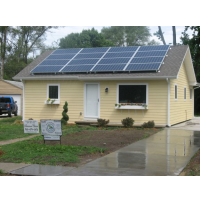Study Says Solar Rebates Not as Effective as Just Giving Units to Low-Income Folks
 (photo: Purdue University)
(photo: Purdue University)
California leads the nation, by far, in developing solar capacity; just think how think how well the state would have done if it hadn’t wasted its money on rebates.
At least, that’s what a new study from Vanderbilt University and Sandia National Laboratories says.
The California Solar Initiative has poured $2.2 billion into subsidizing the growing rooftop solar panel industry and it’s generally been regarded a big success. More than 250,000 projects have been completed.
But doctoral student Haifeng Zhang and Assistant Professor of Computer Science Yevgeniy Vorobeychik at Vanderbilt, in collaboration with Joshua Letchford and Kiran Lakkaraju at Sandia, disagree.
They analyzed 8,500 solar projects in San Diego between May 2007 and April 2013 and found the broad range of financial subsidies had little correlation with the number of adoptees. The growth in popularity would have been about the same without them, the report concludes.
“Despite the fact that policy makers have paid overwhelming attention to increasing the economic benefits by reducing costs to get people to adopt solar technology, our analysis indicates that this has much less effect than generally perceived,” Vorobeychik said.
One of the reasons given for the muted effect of subsidies was a change in how solar panels are marketed. In the beginning, individuals made the purchase and benefited from the subsidy. But the industry shifted, and more solar panels are now leased. The subsidy goes to the lessor, who does not pass the savings along. That’s good for solar leasing company bottom lines, but doesn’t automatically translate into more units being leased.
So, if financial incentives aren’t effective in getting people to strap some big, shiny piece of hardware to their rooftops, what would be? The researchers’ computer model came up with one possibility: Provide solar units for little or no money to a targeted number of low-income families and then let peer pressure take over.
The researchers found that while economic incentives might not influence people to get units, behavior by neighbors does. They found that the more solar units in a neighborhood, the more likely a person was to get one.
That strategy would provide a lot more cheap power and toss in a little income redistribution on the side.
Solar industry folks were, not surprisingly, a tad skeptical of the study. Bernadette del Chiaro, executive director of the California Solar Energy Industries Association, told the Desert Sun in Palm Springs that the report was “absolutely laughable” and predicted that policymakers “are not going to take this seriously.”
The report is scheduled to be presented in May at the Proceedings of the 14th International Conference on Autonomous Agents and Multiagent Systems. It was partially funded by the U.S. Department of Energy, according to the Desert Sun.
–Ken Broder
To Learn More:
California Solar Rebates Not Effective, Study Finds (by Sammy Roth, Palm Springs Desert Sun)
Vanderbilt Study Questions Effectiveness of California Solar Incentive (by Glenn Meyers, Clean Technica)
How California Solar Incentives Could Have Made an Even Bigger Impact (by Scott Thill, SolarEnergy.net)
Want More Solar Cheaper in California? Give It to the Poor, Says Study (by Chris Clarke, KCET)
California’s Solar Incentive Program Has Had Only Modest Impact on Adoption Rates (by David Salisbury, Vanderbilt University)
- Top Stories
- Controversies
- Where is the Money Going?
- California and the Nation
- Appointments and Resignations
- Unusual News
- Latest News
- California Forbids U.S. Immigration Agents from Pretending to be Police
- California Lawmakers Urged to Strip “Self-Dealing” Tax Board of Its Duties
- Big Oil’s Grip on California
- Santa Cruz Police See Homeland Security Betrayal in Use of Gang Roundup as Cover for Immigration Raid
- Oil Companies Face Deadline to Stop Polluting California Groundwater





